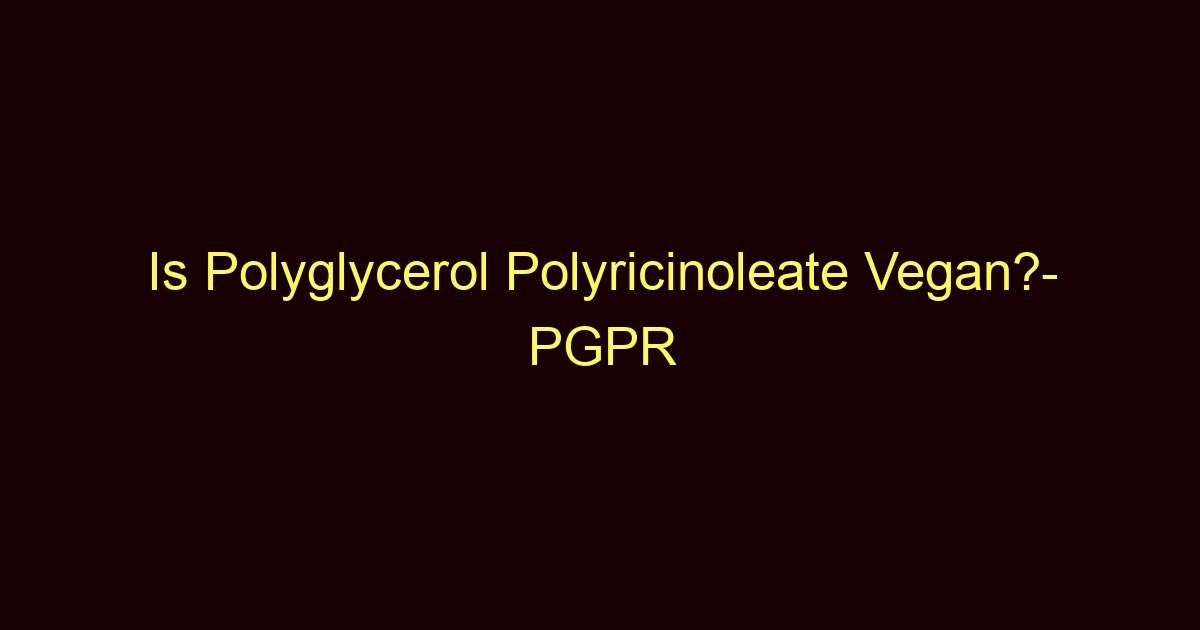From the essentials in our pantry to the ready-to-eat meals on our tables, understanding what goes into our food is more important than ever. One such ingredient that has been generating interest is polyglycerol polyricinoleate. But is it suitable for everyone, especially those following a vegan lifestyle?
What is Polyglycerol Polyricinoleate?
Polyglycerol polyricinoleate, often abbreviated as PGPR, is a yellowish, viscous liquid that is widely used in the food industry. It’s a type of emulsifier, a substance that helps mix oil and water, two components that would typically separate.
First introduced to the food industry in the 1960s, PGPR has found its way into numerous food products. It’s created by polymerizing glycerol with condensed ricinoleic acid. This chemical process results in a product that helps maintain the consistency of foods, and improve their texture and appearance.
From a consumer perspective, the main appeal of PGPR is its functionality. It allows food products to have a smoother texture and extends their shelf life, making it a popular choice for many food manufacturers.
What is Polyglycerol Polyricinoleate Made Of?
The manufacture of PGPR involves two main components: glycerol and ricinoleic acid. Glycerol is a simple compound that’s often derived from plant sources like soybeans or palm. Ricinoleic acid, on the other hand, is a fatty acid extracted from castor oil, a vegetable oil obtained from the seeds of the Ricinus communis plant.
The process of making PGPR involves heating glycerol and ricinoleic acid together, causing them to undergo a series of reactions. This results in the creation of an ester, a compound formed from an acid and an alcohol, which in this case, is the PGPR.
What is Polyglycerol Polyricinoleate Used For?
PGPR is primarily used in the food industry as an emulsifier. It’s especially popular in chocolate and confectionery production, where it helps to reduce the viscosity of the chocolate, making it easier to handle during the manufacturing process. The emulsifying properties of PGPR allow the chocolate to flow more smoothly, resulting in a better texture and appearance.
What Foods Contain Polyglycerol Polyricinoleate?
You will most commonly find PGPR in products that contain chocolate, such as candy bars, chocolate coatings, and other chocolate-based desserts. However, it’s not limited to sweets. Due to its emulsifying properties, PGPR is also used in spreads like margarine, as well as in certain processed foods, where it helps to improve texture and extend shelf life.
Is Polyglycerol Polyricinoleate Vegan?
The good news for those following a vegan diet is that polyglycerol polyricinoleate is typically vegan. As mentioned earlier, it’s made from glycerol, often derived from plants, and ricinoleic acid, extracted from castor oil. As such, no animal products are involved in its production, making it suitable for vegans.
That said, it’s always a good idea for vegans (and everyone else) to check product labels. While PGPR itself is vegan, it’s often used in products that may contain other non-vegan ingredients.
Can Vegans Eat Foods Containing Polyglycerol Polyricinoleate?
Yes, vegans can consume foods containing PGPR, provided the rest of the ingredients are also vegan. It’s important to keep in mind that just because one ingredient is vegan does not automatically make the entire product vegan. Always check labels for other ingredients such as dairy products, eggs, or honey, which are not suitable for a vegan diet.
Other Aspects of Polyglycerol Polyricinoleate
Role of PGPR in the Food Industry
The food industry values PGPR for its ability to improve the texture of food products, particularly chocolates. It reduces the viscosity of chocolate, allowing it to flow better during the manufacturing process. This results in chocolate products with a smoother texture and an improved mouthfeel.
Health Impact of PGPR
While PGPR is considered safe for consumption by regulatory bodies such as the U.S. Food and Drug Administration and the European Food Safety Authority, its impact on health is still an area of ongoing research. As with any food ingredient, moderation is key.
Is Polyglycerol Polyricinoleate Safe?
Polyglycerol polyricinoleate is generally recognized as safe (GRAS) by the U.S. Food and Drug Administration. This means that it is safe for consumption based on a long history of common use in food or on the results of research. However, as with any food additive, it should be consumed in moderation.
Final Thoughts
Polyglycerol polyricinoleate (PGPR) is a food additive that plays a significant role in the food industry, particularly in chocolate production. It’s typically derived from plant-based sources and is therefore considered vegan. However, consumers, especially those following specific dietary patterns such as veganism, should always check food labels to ensure all ingredients align with their dietary needs.

